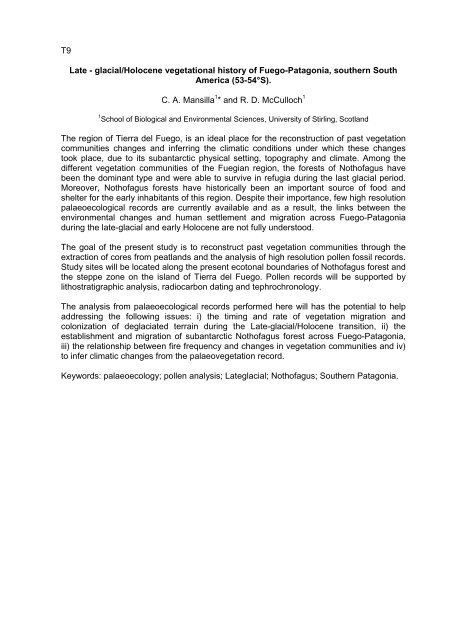The full programme book (PDF) - Royal Geographical Society
The full programme book (PDF) - Royal Geographical Society
The full programme book (PDF) - Royal Geographical Society
Create successful ePaper yourself
Turn your PDF publications into a flip-book with our unique Google optimized e-Paper software.
T9<br />
Late - glacial/Holocene vegetational history of Fuego-Patagonia, southern South<br />
America (53-54°S).<br />
C. A. Mansilla 1 * and R. D. McCulloch 1<br />
1 School of Biological and Environmental Sciences, University of Stirling, Scotland<br />
<strong>The</strong> region of Tierra del Fuego, is an ideal place for the reconstruction of past vegetation<br />
communities changes and inferring the climatic conditions under which these changes<br />
took place, due to its subantarctic physical setting, topography and climate. Among the<br />
different vegetation communities of the Fuegian region, the forests of Nothofagus have<br />
been the dominant type and were able to survive in refugia during the last glacial period.<br />
Moreover, Nothofagus forests have historically been an important source of food and<br />
shelter for the early inhabitants of this region. Despite their importance, few high resolution<br />
palaeoecological records are currently available and as a result, the links between the<br />
environmental changes and human settlement and migration across Fuego-Patagonia<br />
during the late-glacial and early Holocene are not <strong>full</strong>y understood.<br />
<strong>The</strong> goal of the present study is to reconstruct past vegetation communities through the<br />
extraction of cores from peatlands and the analysis of high resolution pollen fossil records.<br />
Study sites will be located along the present ecotonal boundaries of Nothofagus forest and<br />
the steppe zone on the island of Tierra del Fuego. Pollen records will be supported by<br />
lithostratigraphic analysis, radiocarbon dating and tephrochronology.<br />
<strong>The</strong> analysis from palaeoecological records performed here will has the potential to help<br />
addressing the following issues: i) the timing and rate of vegetation migration and<br />
colonization of deglaciated terrain during the Late-glacial/Holocene transition, ii) the<br />
establishment and migration of subantarctic Nothofagus forest across Fuego-Patagonia,<br />
iii) the relationship between fire frequency and changes in vegetation communities and iv)<br />
to infer climatic changes from the palaeovegetation record.<br />
Keywords: palaeoecology; pollen analysis; Lateglacial; Nothofagus; Southern Patagonia.
















